Zcash Halving and Its Impact on Cryptocurrency Market Trends
- Zcash's 2025 halving reduced block rewards to 1.5625 ZEC, mirroring Bitcoin's deflationary model and sparking debates on scarcity-driven valuations. - Structural scarcity, combined with privacy features and institutional adoption, boosted Zcash's price 1,172% YTD, outperforming Bitcoin's 41.2% gain. - Unique mechanisms like ZIP 1015's 12% reward burn and hybrid PoS model differentiate Zcash from Bitcoin/Litecoin, influencing miner sustainability strategies. - Upcoming 2028 halving cycles for Zcash (0.781
Structural Scarcity: A Common Thread
Structural scarcity is a fundamental principle for proof-of-work (PoW) cryptocurrencies, designed to reflect the limited availability of resources like gold. For Zcash, the 2025 halving strengthened its scarcity narrative by slowing the creation of new coins, a mechanism it shares with Bitcoin and Litecoin. Bitcoin’s 2024 halving, which
Zcash distinguishes itself with its focus on privacy.
Market Dynamics: Price Trends and Investor Behavior
The price movements of Zcash, Bitcoin, and Litecoin after their respective halvings reveal differences in investor sentiment. Zcash’s
Even so, Bitcoin’s past halving cycles remain a reference point.
Miner Behavior: Adaptation and Sustainability
How miners respond after halvings provides additional perspective.
Litecoin’s halving, which follows Bitcoin’s reward reduction pattern, has also shaped miner strategies. With rewards now at 3.125 LTC per block,
The Road Ahead: Challenges and Opportunities
Although the narrative of structural scarcity remains compelling, Zcash still faces obstacles. Regulatory pressures on privacy coins could slow adoption, and liquidity issues may arise if miners sell off their reduced rewards. Nevertheless, upcoming improvements to privacy and transaction speed could help mitigate these risks.
Bitcoin’s future is also filled with uncertainty.
Conclusion
Zcash’s 2025 halving has reinforced the ongoing significance of structural scarcity in valuing digital assets. By merging Bitcoin’s deflationary framework with privacy enhancements and institutional interest, Zcash has established a distinct position in the crypto landscape. Still, the varied outcomes for Zcash, Bitcoin, and Litecoin after their halvings show that context—such as utility, regulation, and economic trends—plays a vital role. As future halvings draw near, investors will need to consider these factors alongside supply constraints to navigate the changing world of PoW cryptocurrencies.
Disclaimer: The content of this article solely reflects the author's opinion and does not represent the platform in any capacity. This article is not intended to serve as a reference for making investment decisions.
You may also like
Hayes Focuses on High-Yield DeFi Initiatives Amid Growing Institutional Interest
- Arthur Hayes acquired 2.01M ENA , 218K PENDLE, and 33K ETHFI tokens via Cumberland, totaling $1.42M in DeFi projects focused on yield optimization and automated market-making. - The purchases highlight growing institutional interest in DeFi protocols offering structured products and tokenized derivatives, with ENA and PENDLE leading in governance and yield strategies. - Hayes's strategy aligns with leveraging on-chain data to target undervalued assets, potentially amplifying market sentiment but exposing

Bitcoin Updates: Major Institutions Propel Bitcoin Beyond $90K Amid Expanding ETF Investments
- Institutional investors drove Bitcoin above $90,000 in November 2025 through strategic ETF allocations, including Texas's $10M initiative and Harvard's $443M IBIT stake. - ETF flows showed $238M inflows into spot Bitcoin ETFs despite prior $3.5B outflows, reflecting maturing institutional diversification and crypto-friendly government frameworks. - Texas's planned self-custodied Bitcoin transition and Mubadala's tripled IBIT holdings highlighted growing acceptance of Bitcoin as a strategic reserve asset.

Solana News Update: CHOG Soars by $10M—Meme Coin Frenzy Faces Analyst Cautions Over Market Fluctuations
- CHOG, a Monad ecosystem meme coin, briefly hit $10M market cap on Nov 27, driven by $17.9M 24-hour trading volume. - Monad's mainnet launch (Nov 24) raised $269M via a 1.43x oversubscribed Coinbase ICO, attracting 85,000 participants. - Analysts warn meme coins like CHOG face volatility risks due to social media-driven hype and lack of fundamentals. - Meme coin market reached $47.1B in Q4 2025, with DOGE and SHIB leading despite emerging Solana/Monad projects gaining traction. - Institutional investors r

Vitalik Buterin Backs ZKsync, Igniting Fresh Hopes for Layer 2 Scaling
- ZKsync's Atlas upgrade (Oct 2025) achieved 15,000 TPS and $0.0001 per transfer costs via RISC-V-based zkVM, solving Ethereum's scalability limitations. - Vitalik Buterin's endorsement catalyzed institutional adoption, with Deutsche Bank and Sony leveraging ZKsync for cross-chain settlements and data privacy. - ZK token surged 50% post-endorsement, while ZKsync's TVL reached $3.5B by 2025 through EVM compatibility and liquidity interoperability breakthroughs. - Upcoming Fusaka upgrade (Dec 3, 2025) aims t
